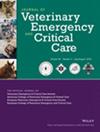Evaluation of the Effects of Detomidine on Equine Myoelectrical Activity Using Electrointestinography
Abstract
Objective
To evaluate the effects of detomidine on equine intestinal slow-wave activity and frequency distribution measured by electrointestinography (EIG).
Design
Prospective, experimental study.
Setting
University teaching hospital.
Animals
A convenience sample of twelve 7- to 21-year-old clinically normal horses.
Interventions
Horses were randomly assigned to saline control (four horses) or detomidine treatment (eight). After obtaining a 30-min baseline EIG, a saline or detomidine bolus was administered, followed by a constant rate infusion, and another EIG was recorded. Ultrasonographic examinations monitored cecal and left ventral colon contractions. Spectral analysis was performed to evaluate changes in dominant frequency, dominant power, total power, percent frequency distribution, and changes in slow-wave rhythmic activity.
Measurements and Main Results
Median (interquartile range [IQR]) dominant frequency in cycles per minute (cpm) was similar for the cecum (2.4 cpm; IQR: 0.51 cpm) and left ventral colon (2.13 cpm; IQR: 0.16 cpm) and unchanged by either treatment (P > 0.074). Compared with saline, which was unchanged, detomidine reduced dominant power ratios for both cecum (0.45; IQR: 0.18) and left ventral colon (0.63; IQR: 0.35; P = 0.002). Detomidine decreased total power for the cecum in the 2–4 cpm frequency range from 55.0% (IQR: 4.4%) to 43.1% (IQR: 6.7%) and for the left ventral colon from 54.4% (IQR: 5.5%) to 27.3% (IQR: 9.3%; P < 0.087). Total power for the cecum was increased in the 8–12 cpm frequency range from 9.6% (IQR: 1.9%) to 18.5% (IQR: 6.6%; P = 0.0044) with detomidine. No change in frequency distribution was noted in controls (P > 0.08). Dominant power correlated with the rate of contractions measured ultrasonographically (P < 0.001).
Conclusions
Detomidine decreased dominant power ratios for both the cecum and left ventral colon and produced tachyarrhythmias in cecal slow-wave activity. The correlation of dominant power with intestinal contractions supports the clinical development of EIG to diagnose equine motility disorders.


 求助内容:
求助内容: 应助结果提醒方式:
应助结果提醒方式:


